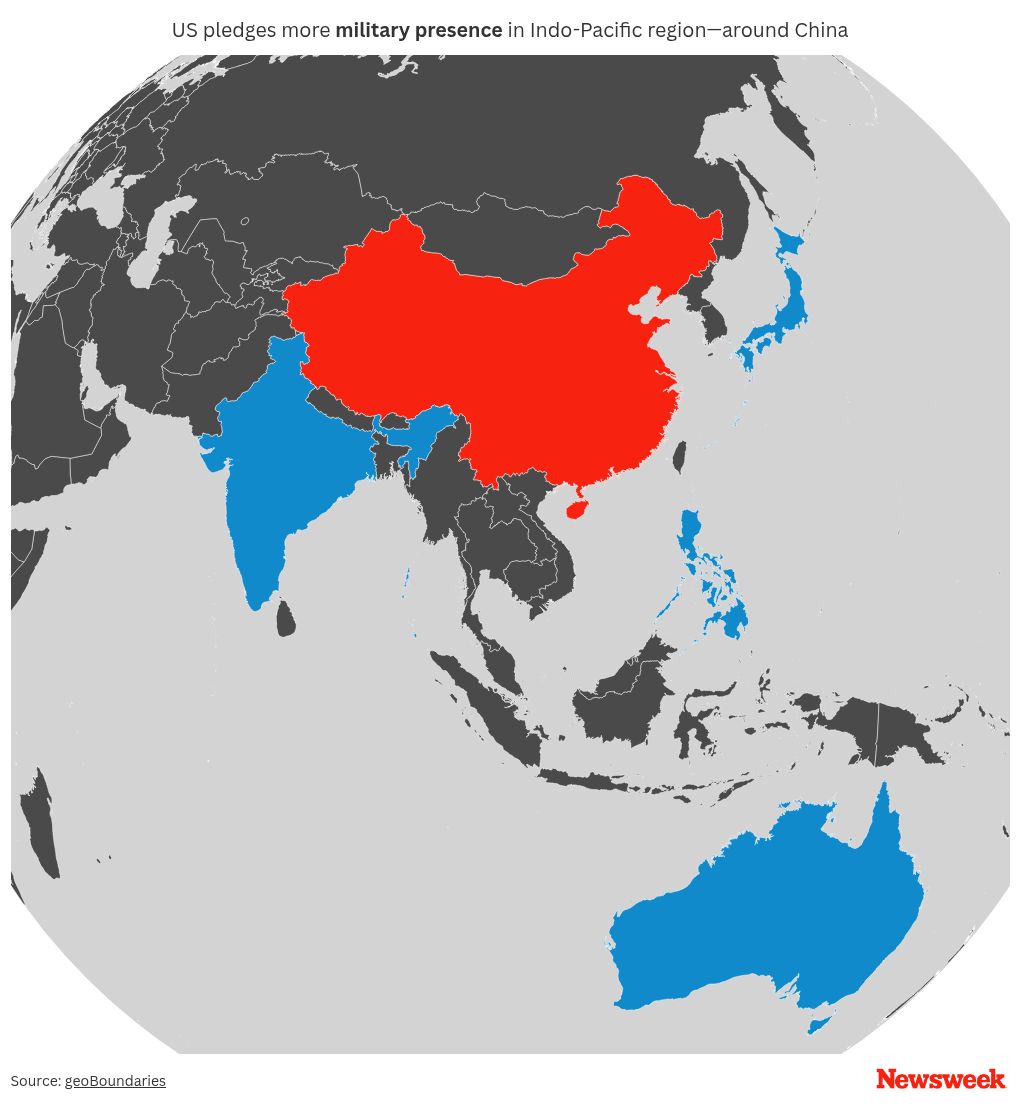U.S. defense chief Pete Hegseth on Wednesday stressed the role of regional partners in the Pentagon‘s bid to counter an increasingly assertive China.
“The Indo-Pacific is our priority theater, and China is our pacing threat,’ he said while making the case for the defense budget requested by the Trump administration for the next fiscal year.
Those words echoed his May 31 remarks at the Shangri-La Dialogue defense summit in Singapore, where he hailed examples of U.S. and allied military cooperation—including those illustrated on the Newsweek map below.

Why It Matters
China‘s rapid military buildup and competing territorial claims have strained ties with several neighbors, including U.S.-allied Philippines and Japan, both of which share defense treaties with Washington that could potentially draw American forces into a conflict.
Chinese threats and increasing military activities around Taiwan, the island democracy Beijing claims as its territory, have further raised concerns. The tensions have driven some of China’s neighbors to deepen military cooperation with the United States and one another.
Newsweek contacted the Chinese Embassy in Washington, D.C., for comment by email, but did not receive a response before publication time.
What To Know
In Singapore, Hegseth praised President Donald Trump‘s “America First” foreign policy while blaming former President Joe Biden for the U.S.-Mexico border crisis to Russia’s invasion of Ukraine.
Yet, he added, “America First certainly does not mean America alone.”
Taking aim at what he called China’s “destabilizing actions,” Hegseth said the U.S. should be prepared for war, although deterring Chinese military aggression by raising its costs was preferable.
“We’re doing this here in the Indo-Pacific in three distinct ways: first, by improving our forward force posture. Second, by helping allies and partners strengthen their defense capabilities. And third, by rebuilding defense industrial bases,” he told attendees.
These efforts include deploying to the first island chain assets such as the U.S. Marine Corps’ NMESIS high-precision anti-ship missile system to the Luzon Strait—a maritime choke point frequented by Chinese warships.
The platform was delivered to the Philippines‘ far-northern Batanes province about 120 miles south of Taiwan. The deployment “enhanced our interoperability and improved our readiness on cutting-edge platforms, where we need them and when we need them,” Hegseth said.
The NMESIS missile system adds to the growing U.S. firepower in the Southeast Asian country. Last year, the U.S. deployed a U.S. Army Mid-Range Capability, also known as the Typhon missile launcher, to the Philippines ahead of joint military drills last spring.
Philippine officials initially suggested the system would be removed after the drills, but later indicated it could remain indefinitely, irking officials in Beijing over the system’s ability to reach China’s eastern seaboard with weapons like as the Standard Missile-6 and the Tomahawk cruise missile.
A second Typhon system will be deployed to AUKUS partner Australia this summer, where the U.S. Army plans to conduct its first-ever live-fire test of the system on foreign soil, Hegseth said.
This year, Washington and Canberra also reached an agreement for Australia to produce 155-millimeter artillery rounds and assemble guided multiple-launch rocket systems, boosting Australia’s potential as a force multiplier in the event of a conflict.

Washington’s efforts to deepen cooperation with Japan, a key Pacific security treaty ally, are also advancing, with upgrades to the joint headquarters of the U.S. Forces Japan. The move will increase deterrence and mark “progress the alliance has made toward improving interoperability and strengthening Japan’s capabilities,” Hegseth said.
The changes, which began in April, will integrate U.S. land, air, sea, space and cyber forces under a single headquarters. There are currently over 50,000 active-duty American military personnel in Japan—the most stationed in any foreign country.
The U.S. is also ramping up cooperation with India, one of the four Quad nations and a country that continues to experience friction with China along its disputed border regions in the Himalayas.
The Pentagon is working with the South Asian country—an increasingly capable arms manufacturer—to “co-produce equipment needed to deter aggression, and this includes negotiating an agreement to bring our industrial bases ever closer,” Hegseth said.
Following February talks in Washington between Trump and Indian Prime Minister Narendra Modi, the two leaders announced an “Autonomous Systems Industry Alliance” that will see the two countries co-develop and co-produce sea drones and counter-drone systems.
What People Are Saying:
Da Wei, director of the Center for International Security and Strategy at Beijing’s Tsinghua University, told Newsweek:“What I want to stress is we are on the path to better relations with regional countries—so we don’t need the U.S. to teach us.”
“I think Secretary Hegseth is kind of trying to [come] between China and regional countries. I don’t think this will be successful.”
What’s Next
The House Appropriations Committee advanced the Pentagon’s request for a base defense budget of $892.6 billion, lower than the $1 trillion figure previously pledged by Trump.
That, along with a $150 billion reconciliation package providing additional funds for priority programs such as shipbuilding and munitions, is expected to pass in the overall congressional vote.
The post Map Shows Where Hegseth Wants US Military on China’s Doorstep appeared first on Newsweek.




